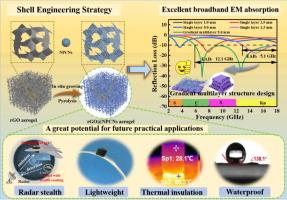在嵌套网状碳结构中,壳体工程可实现介电极化和阻抗改善,从而增强电磁波吸收能力
IF 13.3
1区 工程技术
Q1 ENGINEERING, CHEMICAL
引用次数: 0
摘要
三维还原氧化石墨烯(rGO)气凝胶因其独特的结构优势而在电磁波吸收材料(EWAM)领域展现出巨大潜力,但如何平衡阻抗匹配与电磁衰减能力之间的关系仍是一个挑战。本文提出了一种新颖的外壳工程策略,通过涂覆由大量掺杂 N 的多孔碳纳米管(NPCN)组成的致密连续的异质层,制造出具有嵌套网络结构的三维 rGO 基气凝胶。异质层的形成或多或少地增加了气凝胶结构的稳定性,并抑制了 rGO 纳米片的重新堆积。更重要的是,rGO 气凝胶孔壁上的 NPCNs 是无定形的,因此它们不仅能优化 rGO 气凝胶的阻抗匹配,还能利用与 rGO 气凝胶之间的介电差引起强大的界面极化。因此,最终的 rGO@NPCNs 气凝胶具有良好的电磁吸收性能,特别是在厚度仅为 1.3 毫米的情况下,有效吸收带宽(EAB)达到 5.1 GHz。通过梯度多层结构设计,EAB 值可进一步扩展到 12.1 GHz。数值模拟技术生动地证明,与单个 rGO 气凝胶相比,这种外壳工程策略有助于入射电磁波穿透 rGO@NPCNs 气凝胶,并有利于生成适当的异质界面,以增强界面极化损耗。此外,rGO@NPCNs 气凝胶还具有良好的隔热性能、防水功能和雷达隐身性能,这充分说明了它作为未来高性能 EWAMs 优异候选材料的广阔前景。本文章由计算机程序翻译,如有差异,请以英文原文为准。

Shell engineering afforded dielectric polarization prevails and impedance amelioration toward electromagnetic wave absorption enhancement in nested‐network carbon architecture
3D reduced graphene oxide (rGO) aerogel has exhibited immense potential as electromagnetic (EM) wave absorbing materials (EWAMs) due to its unique structural advantages, but there still remains a challenge to balance the relationship between impedance matching and EM attenuation capability. Herein, a novel shell engineering strategy is proposed to fabricate 3D rGO-based aerogel with nested-network architecture by coating a dense and continuous heterogeneous layer composed of numerous N-doped porous carbon nanocubes (NPCNs). The formation of heterogeneous layer more or less increases the stability of aerogel structure and suppresses the re-stacking of rGO nanosheets. More importantly, NPCNs on the pore walls of rGO aerogel are amorphous, and thus they not only optimize impedance matching of rGO aerogel, but also induce powerful interfacial polarization thanks to the dielectric difference with rGO aerogel. As a result, the final rGO@NPCNs aerogel produces good EM absorption performance, especially for an effective absorption bandwidth (EAB) of 5.1 GHz with a thickness of merely 1.3 mm. The value of EAB can be further extended up to 12.1 GHz by gradient multilayer architecture design. Numerical simulation technique vividly demonstrates that this shell engineering strategy contributes to the penetration of incident EM wave into rGO@NPCNs aerogel as compared with individual rGO aerogels, and facilitates the generation of adequate heterogeneous interfaces to reinforce interfacial polarization loss. Moreover, rGO@NPCNs aerogel also displays good thermal insulation, waterproof functionality, and radar stealth properties, which fully addresses its bright prospects as an excellent candidate for high-performance EWAMs in the future.
求助全文
通过发布文献求助,成功后即可免费获取论文全文。
去求助
来源期刊

Chemical Engineering Journal
工程技术-工程:化工
CiteScore
21.70
自引率
9.30%
发文量
6781
审稿时长
2.4 months
期刊介绍:
The Chemical Engineering Journal is an international research journal that invites contributions of original and novel fundamental research. It aims to provide an international platform for presenting original fundamental research, interpretative reviews, and discussions on new developments in chemical engineering. The journal welcomes papers that describe novel theory and its practical application, as well as those that demonstrate the transfer of techniques from other disciplines. It also welcomes reports on carefully conducted experimental work that is soundly interpreted. The main focus of the journal is on original and rigorous research results that have broad significance. The Catalysis section within the Chemical Engineering Journal focuses specifically on Experimental and Theoretical studies in the fields of heterogeneous catalysis, molecular catalysis, and biocatalysis. These studies have industrial impact on various sectors such as chemicals, energy, materials, foods, healthcare, and environmental protection.
 求助内容:
求助内容: 应助结果提醒方式:
应助结果提醒方式:


